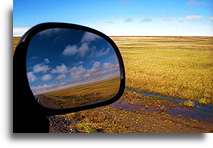

Point Barrow or Nuvuk in Alaska is northernmost point of the United States. It is located on the Arctic Ocean, 534 km / 330 miles above the Arctic Circle. It marks the separation of the Chukchi Sea and the Beaufort Sea. The point was named for the British geographer Sir John Barrow. The city of Utqiagvik (formerly Barrow) is one of the largest Inupiaq settlements in Alaska. This is a real exotic destination where the sun does not set from May 11th to August 2nd.



Arctic tundra is flat and muddy. It is dominated by sedge, heath, moss and lichen. The arctic tundra is influenced by permafrost, a layer of permanently frozen subsoil in the ground. The combination of frozen ground and flat terrain on the tundra impedes the drainage of water. Held at the surface or saturating the upper layer of soil, the water forms ponds and bogs that provide moisture for plants.


Skin whaling boats called umiaks are still used for hunting sea animals in spring. The one shown on a picture is covered with walrus skin. Whaling is still practiced by Inupiaq families, and they are also allowed to hunt polar bear.



The Inupiaq people have not had a written system for centuries. The only way to pass knowledge from one generation to another was through stories and songs. Their culture was different that European. They had a completely different sense of property rights. Individual clans had rights to selected dances, for example, but land was common. The Inupiaq language is spoken from northeastern Siberia to Greenland. It is one of the most complex and difficult languages in the world. This is proven by the fact that apparently no European trader or explorer has ever been able to speak the language fluently.




